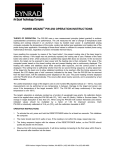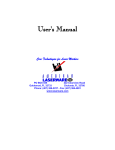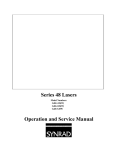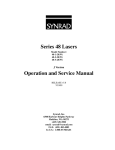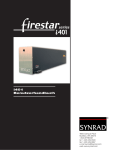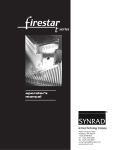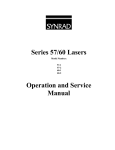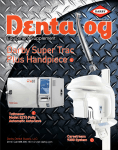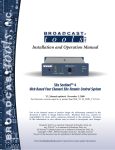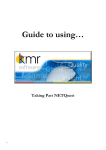Download SH-series Marking Head Operation Manual
Transcript
SH SERIES MARKING HEAD OPERATION AND SERVICE MANUAL RELEASE v1.2 DATE: 1/23/96 Synrad, Inc. 11816 North Creek Parkway N. Bothell, WA 98011 (206) 483-6100 email: [email protected] FAX: (206) 485-4882 In U.S.: 1-800-SYNRAD1 SH Series Marking Head Operation and Service Manual TABLE OF CONTENTS 1. INTRODUCTION........................................................................................................................................................ 1 1.1 SYNRAD SH SERIES M ARKING HEAD ......................................................................................................................1 1.2 SAFETY REQUIREMENTS...........................................................................................................................................3 2. DESCRIPTION OF SH SERIES MARKING HEAD.............................................................................................. 6 2.1 TECHNICAL SPECIFICATIONS ...................................................................................................................................6 2.2 PHYSICAL FEATURES..................................................................................................................................................7 2.3 SYSTEM REQUIREMENTS.........................................................................................................................................11 2.4 SYSTEM OPTIONS .....................................................................................................................................................13 3. UNPACKING/INITIAL INSPECTION...................................................................................................................14 4. SETUP REQUIREMENTS........................................................................................................................................15 4.1 M OUNTING.................................................................................................................................................................15 4.2 A LIGNMENT ...............................................................................................................................................................17 5. OPERATING INSTRUCTIONS..............................................................................................................................20 5.1 GENERAL ....................................................................................................................................................................20 5.2 A NALOG INPUT CABLE............................................................................................................................................20 5.3 COMPUTER SOFTWARE ...........................................................................................................................................20 5.4 W ORK SURFACE REQUIREMENTS..........................................................................................................................20 5.5 ELECTRICAL CONNECTIONS ...................................................................................................................................21 5.6 M ARKING FIELD AND COORDINATE SYSTEM .....................................................................................................21 5.7 SETTING W ORKING DISTANCE ..............................................................................................................................23 5.8 TURN-ON/CHECK-OUT .............................................................................................................................................23 5.9 CHANGING FOCUSING LENS .....................................................................................................................................24 6. OPERATION WITH PROLASE SOFTWARE AND SYNRAD LASERS ......................................................25 6.1 PC-M ARKING HEAD D/A INTERFACE ...................................................................................................................25 6.2 PROLASE SOFTWARE ................................................................................................................................................27 6.3 SYNRAD LASER CONNECTIONS...............................................................................................................................29 7. MAINTENANCE AND SERVICE...........................................................................................................................31 7.1 DAILY INSPECTIONS.................................................................................................................................................31 7.2 FOCUSING LENS CLEANING INSTRUCTIONS..........................................................................................................31 8. RETURN FOR FACTORY SERVICE....................................................................................................................34 APPENDIX A LIST OF SUPPLIERS ...................................................................................................................................................35 APPENDIX B SYNRAD SH SERIES MARKING HEAD MOUNTING KIT...........................................................................................................................37 i SH Series Marking Head Operation and Service Manual List of Figures FIGURE 1-1 LASER RADIATION W ARNING LABELS .....................................................................................................3 FIGURE 1-2 LOCATION OF W ARNING LABELS..............................................................................................................4 FIGURE 1-3 LOCATION OF M ANUFACTURER’S PLACARD AND CE COMPLIANCE LABEL ................................5 FIGURE 2-1 PHYSICAL FEATURES...................................................................................................................................8 FIGURE 2-2 PHYSICAL FEATURES...................................................................................................................................9 FIGURE 2-3 LASER M ARKING SYSTEM.........................................................................................................................11 FIGURE 4-1 TYPICAL M ARKING HEAD M OUNTING..................................................................................................15 FIGURE 4-2 PLANES OF M OVEMENT REQUIRED FOR A LIGNMENT ........................................................................16 FIGURE 4-3 LOCATION OF M ARKING HEAD M OUNTING HOLES ............................................................................17 FIGURE 4-4 BEAM A LIGNMENT TOOL.........................................................................................................................18 FIGURE 5-1 FIELD COORDINATE SYSTEM ..................................................................................................................22 FIGURE 5-2 M ARKING FIELD RELATIVE TO M ARKING HEAD ................................................................................22 FIGURE 5-3 M EASUREMENT OF W ORKING DISTANCE .............................................................................................23 FIGURE 6-1 DADIO SWITCH /JUMPER SETTINGS ......................................................................................................25 FIGURE 6-2 DADIO-M ARKING HEAD INTERFACE CABLE .......................................................................................26 FIGURE 6-3 CIO-DDA06 SWITCH /JUMPER SETTINGS ..............................................................................................27 FIGURE 6-4 CIO-DDA06-M ARKING HEAD INTERFACE CABLE ..............................................................................28 FIGURE 6-5 UC-1000 INTERCONNECTION DIAGRAM.................................................................................................30 List of Tables TABLE 1-1 SH SERIES FEATURES AND BENEFITS........................................................................................................1 TABLE 2-1 SPECIFICATION TABLE ................................................................................................................................6 TABLE 2-2 A NALOG INPUT CONNECTOR PIN A SSIGNMENTS.................................................................................10 TABLE 5-1 NOMINAL FOCAL LENGTH/FIELD SIZE RELATIONSHIP .......................................................................21 TABLE 6-1 DADIO-M ARKING HEAD INTERCONNECT W IRING..............................................................................26 TABLE 6-2 CIO-DDA06-M ARKING HEAD INTERCONNECT W IRING......................................................................28 TABLE 7-1 CLEANING M ATERIALS..............................................................................................................................32 TABLE 7-2 SELECTION OF CLEANING SOLVENT .......................................................................................................32 ii SH Series Marking Head Operation and Service Manual 1. Introduction Laser-based marking and cutting systems are typically characterized in terms of speed and accuracy. Conventional systems employ a type of motion control system that requires movement of either the laser or the work surface, both of which have mass and therefore inertia. These dynamics significantly limit acceleration/deceleration rates and positional resolution. The ideal solution is to provide a method which requires movement of that component of the system with the least amount of mass, the laser beam. Since the laser beam has no practical mass, potential limitations on speed and accuracy are imposed only by the method used to move the laser beam. 1.1 Synrad SH Series Marking Head At Synrad, we have used our technical expertise to design and manufacture the SH Series, a unique Marking Head that provides a high performance, low cost beam control solution for a wide range of marking and cutting applications (refer to Table 1-1 for a summary of the SH Series features and benefits). FEATURES Table 1-1 SH Series Features and Benefits BENEFITS Large (15 mm) Marking Aperture Single Pupil Optical System Internal Distortion Compensation All Reflective Internal Optical Design Choice of Internal Expansion Ratio Low Cost Implementation Programmable Galvos Smaller f/# for a given focal length produces smaller spot size providing greater resolution. Zero distortion in the image plane. Automatic elimination of pin cushioning and barreling. YAG or CO2 interchangeable by simply changing the final focusing lens. Optimize any manufacturer’s YAG or CO2 laser for operation with the Marking Head. Requires only a PC, CAD software, laser marking program, and D/A card. Suitable for a wide variety of production applications: -high volume, low-mix. -low volume, high mix. -individual, one-off jobs. 1 SH Series Marking Head Operation and Service Manual 1.1 Synrad SH Series Marking Head (Continued) Control of the laser is accomplished using small, lightweight mirrors attached to computer controlled galvanometer motors. This provides a simple but effective method of positioning a focused laser beam in an X-Y plane. The combination of these scanning mirrors and additional optical components such as beam expanders and focusing lenses provides an ideal method for a wide range of writing, cutting, and marking applications. The unique design of the internal optics of the Marking Head coupled with a single large exit pupil provide the fastest scan speeds while providing the smallest spot sizes over the entire scanned area. The single pupil configuration operates without the astigmatism (optical non-linearity) associated with other scanner designs. The SH Series incorporates an internal beam expander, with a variety of available expansion ratios, to transform any input beam diameter into a beam large enough to fill the exit aperture. This results in the smallest possible spot size for a given focal length lens improving system speed and resolution compared to conventional systems. To ensure that the head is compatible with both YAG and CO2 lasers, all internal optics are of a reflective design, with broadband coatings equally reflective at both 1.06 and 10.6 µm. This feature also allows the same head to be interchanged between YAG and CO2 lasers by replacing only the final focusing lens. Control electronics and distortion compensation are integrated into the compact head design and are easily accessible by removing the top cover. Pin cushioning and barreling effects normally encountered with flat field marking systems are eliminated. No further software correction for astigmatism is required. Recent developments in software control and on-line product monitoring have led to numerous applications in high-speed manufacturing facilities. The programmable nature of the galvanometers allows the scanning mirrors to be positioned in a way that allows the laser to track and mark the product as it moves along the production line. This 'marking on the fly' makes the SH Series ideally suited for manufacturing applications with capacities of thousands of units per hour. The laser marking program generates the required drive and control signals for both the Marking Head and the laser (through the D/A card). Alphanumerics and simple drawings may be created within the laser marking program itself. In addition, standard graphics applications such as AUTOCAD® and CorelDRAW® can be used to generate high quality graphics, logos and text which can be easily read by the laser marking program to provide the required drive outputs to the Marking Head. 2 SH Series Marking Head Operation and Service Manual 1.2 Safety Requirements To prevent exposure to direct or scattered laser radiation, follow all safety precautions specified throughout this manual. Use of controls or adjustments or performance of procedures other than those specified herein may result in hazardous invisible radiation exposure. Safe operation of the Marking Head also requires the user follow all precautions specified in the operator’s manual provided by the manufacturer of the laser beam. There are two types of warning labels affixed to the Marking Head. Aperture warning labels identify all apertures through which the laser beam travels and from which exposure to laser radiation could occur. Protective cover labels identify all covers or enclosures which if open during operation could result in exposure to laser radiation. Each of these labels is shown in Figure 1-1. The location of each is shown in Figure 1-2, Page 4. Figure 1-1 Laser Radiation Warning Labels There are two types of precautions that appear throughout the manual: a WARNING and a CAUTION. Any process or procedure that could result in exposure to laser radiation if not properly performed will be preceded by the following notation: WARNING Any process or procedure that could result in damage to the Marking Head if not properly performed will be preceded by the following notation: CAUTION A manufacturer’s placard is also affixed to the Marking Head indicating date of manufacture, model number, and electrical power requirements. The location of the manufacturer’s placard is shown in Figure 1-3, Page 5. 3 SH Series Marking Head Operation and Service Manual 1.2 Safety Requirements (Continued) Figure 1-2 Location of Warning Labels 4 SH Series Marking Head Operation and Service Manual 1.2 Safety Requirements (Continued) Figure 1-3 Location of Manufacturer’s Placard and CE Compliance Label 5 SH Series Marking Head Operation and Service Manual 2. Description of SH Series Marking Head 2.1 Technical Specifications Synrad's SH Series Marking Heads are available for both YAG and CO2 lasers with numerous interchangeable focusing lenses to provide a range of field sizes, spot diameters, and focal lengths. A choice of beam expander ratios allows users to match perfectly their laser input beam to the SH Marking Head (see Para. 2.4.1, Page 13 for further details on selection of beam expanders). The specification table (refer to Table 2-1) provides technical information for Synrad's SH Series of Marking Heads with standard focusing lenses for both YAG and CO2 lasers. The specifications are based on a system with a 3x beam expander (as recommended for operation with Synrad lasers). Table 2-1 Specification Table Model Number SH3-U Field Size (mm) – Spot Size at 50% (µm) ** – – – 2 Spot size at 1/e (µm) Working Distance From Lens Mount (mm) Scan Angle (degrees) SH3200C 110 x 110 176 CO2 SH3SH3125C 69C 70 x 38 x 70 38 110 60 160 88 220 90 40 20 236 144 73 99 655 283 142 – 14 13 10 0 16 15 13 Unfocuse 200 125 69 172 550 250 125 15 2 Input Beam Diameter at 1/e (mm)* Continuous Input Power(W) 3-4 65 50, Q-switched Settling Time, Full Field (ms) <5 Full Amplitude Drive Freq (Hz) 130 Size (mm) Weight (kg) SH3125Y 69 x 69 15 250 Scanning Aperture (mm) Input Power SH3550Y 305 x 305 65 48, diagonal Beam Angle to Surface Normal, Max. (degrees) Effective Focal Length (mm) Field Distortion, Relative to Drive Voltage Drive Signals SH3172C 95 x 95 150 YAG SH3250Y 138 x 138 30 < 0.1% ± 10VDC, each axis 28-30VDC @ 3 A maximum 140W x 250L x 250H 5 * For input beam diameters < 3mm, use optional suffix 4, 5, 6, 7.5, and 10 after “SH” (i.e., SH6-250Y) to indicate larger beam expansion ratio. Consult Synrad for larger input beam diameters. ** Corresponds to typical engraving results. 6 SH Series Marking Head Operation and Service Manual 2.2 Physical Features The physical features of the Marking Head are shown in Figure 2-1, Page 8 and Figure 2-2, Page 9 and are described in the following paragraphs. 2.2.1 Electronics Cover A removable cover to provide access to the internal electronics. 2.2.2 Y-Axis Galvo Cover A removable cover that provides access to the Y-Axis galvo. 2.2.3 Expanding Mirror Mount Externally mounted assembly that retains the internal expanding mirror. A number of different beam expanders are available to allow users to optimize Marking Head performance for a variety of marking and cutting applications. 2.2.4 Focusing Lens Externally mounted lens that focuses the laser beam for marking and cutting applications. A number of lens options are available in a variety of focal lengths to provide different field and spot sizes for CO2 or YAG laser compatibility. These lenses can be interchanged on the Marking Head by the user without any additional modifications. 2.2.5 X-Axis Galvo Cover A removable cover that provides access to the X-Axis galvo. 2.2.6 Power On LED A panel mounted LED for indicating Marking Head power is on. Illumination of the LED typically lags power switch activation by approximately 2 seconds. 2.2.7 Power Switch A panel mounted, rocker switch for turning Marking Head power on and off. 2.2.8 Y-Output Connector BNC-style connector for the Y-Output signal. This signal is a DC voltage that represents the true mechanical position of the Y-axis galvo (1.172 volts per degree of angular rotation over a range of ±7.5° relative to the galvo zero position). The actual output voltage differs from the associated input in that a correction factor is applied to compensate for optical astigmatism. This interconnect is an optional output provided for monitoring purposes and is not required for system operation. 7 SH Series Marking Head Operation and Service Manual Figure 2-1 Physical Features 2.2.9 Beam Entrance Aperture Entrance aperture for the laser beam. Safe operation of the Marking Head requires installation of a beam enclosure tube between the exit aperture of the laser and the entrance aperture of the Marking Head. 2.2.10 Gate Out Connector A BNC style connector that provides the gate control signal for turning the external laser on and off. This signal is routed from pin 7 of the analog input connector to the Gate Out connector. The characteristics of this output are determined by the requirements of the laser controller. For use with a Synrad laser, this connector provides a TTL-output to drive Synrad’s UC-1000 Universal Controller. 8 SH Series Marking Head Operation and Service Manual Figure 2-2 Physical Features 2.2.11 Power Input Connector A panel mounted, circular connector that provides 28-30VDC operating power to the Marking Head. 2.2.12 Fuse Holder A panel mounted fuse holder. The required fuse is rated at 28VDC, 3A (slow blow). 2.2.13 Power Control Output Connector A BNC-style connector that provides a DC voltage to control the power output level of the external laser. This signal is routed from pin 6 of the analog input connector to the power level control connector. The characteristics of this output are determined by the requirements of the laser controller. For use with a Synrad laser, this connector provides a 0 - 10VDC output to drive a Synrad UC-1000 Universal Controller. 9 SH Series Marking Head Operation and Service Manual 2.2.14 Analog Input Connector A DB9 connector that provides the interconnect for all required drive inputs to the Marking Head. The pin assignments for the connector are provided in Table 2-2. Table 2-2 Analog Input Connector Pin Assignments PIN NUMBER 1 SIGNAL NAME External Modulation 2, 3, 4, 5 Ground 6 Laser Power Control Connected to Power Control Output connector through 1 kΩ resistor. Refer to Para. 2.2.13, Page 9. 7 Laser Gate Control Connected to Gate Out connector through 1 kΩ resistor. Refer to Para. 2.2.10, Page 8. 8 X-Input DC input voltage to control the position of the X-axis galvo (± 10VDC). 9 Y-Input DC input voltage to control the position of the Y-axis galvo (± 10VDC). FUNCTION Connected to Ext. Mod. Out. Refer to Para. 2.2.15. 2.2.15 Ext. Mod. Out A BNC-style connector that provides a control signal to the laser for external frequency modulation. This is routed directly from Pin 1 of the analog input connector. This output can be used to control power and frequency on CO2 and YAG lasers. 2.2.16 X-Output Connector A BNC-style connector for the X-Output signal. This signal is a DC voltage that represents the true mechanical position of the X-axis galvo (1.172 volts per degree of angular rotation over a range of ±7.5° relative to the galvo zero position). The actual output voltage differs from the associated input in that a correction factor is applied to compensate for optical astigmatism. This interconnect is an optional output provided for monitoring purposes and is not required for system operation. 10 SH Series Marking Head Operation and Service Manual 2.3 System Requirements A complete laser marking system is shown in Figure 2-3 and consists of the following: Laser (CO2 or YAG) System Laser Controller SH Series Marking Head Mounting Structure 28VDC Power Supply D/A Board Computer System Laser Marking Program/CAD Software Figure 2-3 Laser Marking System 2.3.1 Laser (CO2 or YAG) System Any manufacturer's laser can be configured with Synrad's marking heads provided that the maximum specified power levels are not exceeded and that the correct beam expander ratio is selected. The laser should have the capability for remote power control and remote on/off switching (refer to Para. 2.3.2, Page 12). 11 SH Series Marking Head Operation and Service Manual 2.3.1 Laser (CO2 or YAG) System (Continued) Synrad lasers operate at 28VDC input power. The Marking Head can be powered off of the same 28VDC power supply. 2.3.2 Laser Controller For any type of laser, a control module must be provided (in some lasers this may be integral to the laser system) that can accept the signals from the D/A card in the computer. These signals gate the laser on and off, control output power, and, in the case of YAG lasers, control the Q-switch frequency. To operate a Synrad laser with the SH Series Marking Head an external laser controller is required. The Synrad UC-1000 Universal Controller has been designed to provide necessary control of the laser output from a remote source. The UC-1000 requires 28VDC at 80mA from a wall plug transformer/rectifier or laser supply. 2.3.3 SH Series Marking Head Incorporates internal, reflective beam expander, x- and y-axis galvo scanners, galvo drive cards, distortion compensation card, and flat field focusing lens. Requires 28VDC operating voltage plus four input signals for laser and scanner control (refer to Para. 2.3.6). For operation with Synrad lasers, one 28VDC power supply may be used to power both laser and Marking Head. 2.3.4 Mounting Structure A means of mounting the Marking Head is required to maintain the alignment of the laser beam with the internal mirrors of the Marking Head. 2.3.5 28VDC Power Supply Available from a variety of manufacturers, these power supplies need to generate 6A at 28VDC for the Marking Head plus additional current capability for power requirement of the laser. Refer to Appendix A, Page 35 for recommended suppliers. 2.3.6 Digital-to-Analog Drive Board D/A drive board mounted in the computer system must be capable of providing the following signals to the Marking Head and laser controller: X-Input Y-Input Laser power control Laser on/off (gate) +/- 10VDC +/- 10VDC 0-10VDC (Synrad UC-1000) TTL (Synrad UC-1000) These boards are available from a variety of sources. Refer to Appendix A, Page 35 for possible suppliers. 12 SH Series Marking Head Operation and Service Manual 2.3.7 Computer System Dependent on software requirements but minimum specifications are typically: 33 MHz/386 DX PC 387 math co-processor 1Mb RAM VGA graphics For enhanced performance, a 486DX-based PC is recommended. 2.3.8 Laser Marking Program/CAD Software This software will provide the means to convert a CAD file to a format suitable for driving the Marking Head. Refer to Appendix A, Page 35 for recommended suppliers. These software packages convert the images and text generated in commercial CAD packages such as AUTOCAD® and CorelDRAW® into a suitable output for the Marking Head. They also include software routines for control of the laser and offer outputs to other external devices such as work handlers and transport mechanisms. These commercial drivers also have some onboard graphic and text capability for creation of images, logos, and alphanumerics. 2.4 System Options The following options are available for configuring the Marking Head for a particular application. For assistance in selecting the most suitable options or for more details on particular options, please contact the factory on our toll-free number 1-800-SYNRAD1. 2.4.1 Beam Expanders To ensure optimum performance of Synrad's SH Marking Heads, the input laser beam should be collimated and 10 to 15 mm in diameter. To enable users to match the SH Marking Head to their lasers Synrad offer a choice of six beam expander ratios: 3x, 4x, 5x, 6x, 7.5x and 10x. For use with Synrad lasers, users should specify 3x expander ratios. 2.4.2 Mounting Platform Synrad can supply a complete mounting platform to accommodate a Synrad CO2 laser and Marking Head for easy mounting and alignment. The mounting platform is provided with a beam enclosure tube. 13 SH Series Marking Head Operation and Service Manual 3. Unpacking/Initial Inspection Place the shipping container on a sturdy, level surface and open the top of the box. Verify that the following items are included in the container: The SH Series Marking Head Orange protective covers over the beam entrance aperture and the focusing lens Operation and Service Manual Power Connector 2 BNC-Terminated Interconnect Cables Orange Output Aperture Cap Beam Alignment Tool 4 each #8 screws EmmuLase Software Disk If a D/A card was purchased from Synrad, then the following is also included: D/A Card D/A Software Disk D/A User’s Manual D/A Calibration Tool Analog Input Cable Carefully remove the SH Series Marking Head from the container and remove the outer foam packing material. Do not discard the shipping container or the foam packing since these are required if the Marking Head is ever returned to Synrad for factory service. Inspect the Marking Head housing for any visible signs of shipping damage. Verify that the beam entrance aperture and focusing lens protective covers are installed. Also verify that all external labels and placards are attached to the housing (refer to Para. 1.2, Page 3). Contact Synrad, if the Marking Head housing is damaged or if any of the required materials, labels, or placards are missing. 14 SH Series Marking Head Operation and Service Manual 4. Setup Requirements 4.1 Mounting The Marking Head must be mounted in a manner that allows precise alignment of the laser to the beam expansion optics within the Marking Head, and adjustment of the distance between the focusing lens and the work piece. Although the Marking Head can be mounted in any orientation, the same may not be true of the laser. Check the manual provided with your laser for suggested mounting orientation. If you also purchased the mounting kit for the Marking Head and laser, refer to Appendix B, Page 37 for specific installation/mounting instructions. WARNING When mounting the Marking Head with lasers from other manufacturers, ensure the beam attenuator function is not adversely affected by the Marking Head or the mounting configuration. Because a number of acceptable mounting orientations are possible, the actual orientation will depend on the unique requirements of the user. Therefore the following information stresses important considerations independent of the actual orientation. Also prior to mounting, ensure that the selected mounting orientation will satisfy all work surface requirements specified in Para. 5.4, Page 20. A typical mounting arrangement is shown in Figure 4-1. The Marking Head and laser are aligned horizontally on a common mounting surface. There is adequate distance between the work surface and the focusing lens to accommodate material/work pieces of different sizes. Figure 4-1 Typical Marking Head Mounting 15 SH Series Marking Head Operation and Service Manual 4.1 Mounting (Continued) The distance between the Marking Head and the laser should be adequate to install a beam enclosure tube. The beam enclosure tube prevents exposure to laser radiation and prevents airborne contaminants from entering the Marking Head through the entrance aperture. WARNING To prevent exposure to harmful laser radiation, install a beam enclosure tube to fully enclose the laser beam as it travels between the output aperture of the laser and the entrance aperture of the Marking Head. The internal optics have been pre-aligned at the factory and do not require adjustment by the user. It will be necessary, however, to align the laser to the Marking Head. Refer to Figure 4-2 for an illustration of the planes of movement required for alignment. Figure 4-2 Planes of Movement Required for Alignment The Marking Head is designed to allow mounting using either the bottom or front surfaces. Six mounting holes are located on the bottom surface and eight are located on the front surface (refer to Figure 4-3, Page 17). All mounting holes are reinforced with heli-coil inserts that accept #8-32 screws with a maximum length of 3/16 inch (4.7 mm). 16 SH Series Marking Head Operation and Service Manual 4.1 Mounting (Continued) CAUTION Do not mount the Marking Head directly to the laser housing without additional support. The weight of the Marking Head may cause permanent damage to the laser housing or distort system alignment. Figure 4-3 Location of Marking Head Mounting Holes 4.2 Alignment Alignment of the Marking Head is achieved by adjusting the relative position of the Marking Head and the external laser until the laser beam passes through the center of both the entrance and the expanding mirror mount apertures. This process, referred to as boresighting, requires positional adjustments to either the laser or the Marking Head depending upon specific mounting characteristics (refer to Para. 4.1, Page 15). The alignment process requires the use of the supplied beam alignment tool. This tool is inserted into either the entrance aperture or the aperture exposed by removing the expander mirror mount. It is held securely in place by the outer springs. When the beam alignment tool is inserted into either aperture, the laser beam heats the screen, producing 17 SH Series Marking Head Operation and Service Manual 4.2 Alignment (Continued) a glowing orange spot. Proper alignment is achieved by precisely adjusting the position of the Marking Head or laser until the glowing spot is centered relative to the alignment hole. Figure 4-4 Beam Alignment Tool 1. 2. 3. 4. Verify that power to the laser is off. Remove protective cap from beam input aperture. Remove the four mounting screws that secure the expander mirror mount assembly to the Marking Head housing. Place the expander mirror mount in a protective case. CAUTION 5. 6. Ensure that expander mirror mount is not subjected to any physical shock when removed from the Marking Head housing. Do not adjust the button head screws that secure the expander mirror to the mirror mount. The expander mirror mount is an integral part of the internal optics of the Marking Head and is aligned at the factory. Insert the beam alignment tool into the beam entrance aperture of the Marking Head. Make certain the tool is seated flush against the Marking Head and is not cocked in the hole. Ensure laser output power is set to minimum. 18 SH Series Marking Head Operation and Service Manual 4.2 Alignment (Continued) 7. Turn laser power on and gradually increase output until an orange glow just appears on the screen of the alignment tool. WARNING Harmful laser radiation is emitted through the open expanding mirror mount aperture. 8. 9. 10. 11. 12. Adjust the relative horizontal and elevation of the Marking Head/Laser installation until the orange spot is centered relative to the alignment hole in the screen. Turn laser power off. Move the beam alignment tool to the exit aperture (exposed by removal of the expander mirror mount). Make certain the tool is seated flush against the Marking Head and is not cocked in the hole. Ensure laser output power is set to minimum. Turn laser power on and gradually increase output until an orange glow just appears on the screen of the alignment tool. WARNING Harmful laser radiation is emitted through the open expanding mirror mount aperture. 13. Adjust the relative angular positioning (pitch and yaw) of the Marking Head/laser installation until the orange spot is centered relative to the alignment hole in the screen. 14. Turn laser power off. 15. Repeat Step 5 through Step 14 as required to achieve proper alignment. 16. After proper alignment has been verified, secure the laser and Marking Head in their aligned position. 17. Repeat Step 5 through Step 12 to verify alignment, except adjustments are not required after securing Marking Head/laser mounts. 18. Remove beam alignment tool. 19. Install the expander mirror into the exit aperture and secure with the four screws. This completes laser-Marking Head alignment. No further alignment is required. 19 SH Series Marking Head Operation and Service Manual 5. Operating Instructions 5.1 General Proper operation of the Marking Head-laser system requires consideration of several configuration and performance aspects relating to the laser, Marking Head, and computer system. Refer to Para. 2.3, Page 11 for system component requirements. 5.2 Analog Input Cable The analog input cable connects the Marking Head to the D/A card. The analog input cable is provided if you purchased a D/A card from Synrad. This cable must be terminated using a DB9 connector wired according to the pinout requirements specified in Table 2-2, Page 10. Connections at the other end of the cable are defined by the D/A card. Refer to Para. 6.1.1, Page 25 if you are using a Scientific Solutions DADIO card, and Para. 6.1.2, Page 27 if you are using a Computer Boards, Inc. card. 5.3 Computer Software Control of the Marking Head is accomplished using a 386, 486, or Pentium based personal computer. The selected software should provide the necessary drive signals to allow text and CAD geometry to be transferred from the computer to the Marking Head. Information on recommended software vendors is provided in Appendix A, Page 35. A copy of Synrad’s EmmuLase software is included with the Marking Head. EmmuLase allows you to use the Marking Head as a “printer.” from windows-based applications (e.g., AutoCAD, Corel Draw). To install EmmuLase, run A:\Install from the File menu in Windows. The EmmuLase Help menu provides additonal information. Users may elect to develop software for specific applications. However, this will require an advanced understanding of software design and principles of Marking Head operation. 5.4 Work Surface Requirements The work surface used for cutting or marking of material should meet the following requirements: 1. 2. 3. To avoid laser reflections back into the Marking Head, the marking surface should be non-reflective. Black-anodized aluminum is recommended. To assure a uniform, focused beam diameter over the entire marking field, the surface should be flat and parallel to the Marking Head mounting surface. Recommended ratings are a surface flatness of ± 0.001 inch per inch of work surface and parallelism of ± 0.01 inch. To accommodate material of different thickness and to optimize marking/cutting performance, the distance between the Marking Head and the work surface should be adjustable. 20 SH Series Marking Head Operation and Service Manual 5.4 Work Surface Requirements (Continued) 4. To minimize contamination of the focusing lens, airflow across the work surface should be provided at a rate sufficient to prevent smoke and debris from the cutting and marking process from settling on the lens. To provide orientation relative to the Marking Head, the work surface should employ a method to allow repeatable X/Y alignment and rotational adjustments. 5. 5.5 Electrical Connections Electrical setup of the Marking Head requires performing the interconnects described in the following procedure. Also refer to Figure 6-5, Page 30. 1. 2. 3. 4. 5. Verify that power is off for all system components. Connect the analog input cable between the Marking Head and the computer and tighten into place. (If you purchased a D/A card from Synrad, this cable is provided with your system.) The cable should be wired according to Table 2-2, Page 10. Attach BNC-terminated cable between the PWR CTRL OUT connector on the back panel of the Marking Head and the laser controller (ANV input on Synrad’s UC-1000 Laser Controller). Attach BNC-terminated cable between the GATE OUT connector on the back panel of the Marking Head and the laser controller (GATE input on Synrad’s UC-1000 Laser Controller). Attach the power cable between the PWR connector on the back panel of the Marking Head and the 28VDC power supply. 5.6 Marking Field and Coordinate System The laser marking program must be configured for the field size of the Marking Head. Table 5-1 specifies the nominal field size for three different focal length lenses. The actual factory-calibrated field size value and the factory-calibrated working distance (refer to Para. 5.7, Page 23) is marked on each focusing lens. Table 5-1 Nominal Focal Length/Field Size Relationship Focal Length 200 mm 125 mm 69 mm Field Size 110 mm 70 mm 38 mm The field coordinate system used to determine spot location is shown in Figure 5-1, Page 22 and Figure 5-2, Page 22. When configuring the laser marking program for field size, any correction terms used to compensate for optical distortion should be disabled. 21 SH Series Marking Head Operation and Service Manual 5.6 Marking Field and Coordinate System (Continued) Figure 5-1 Field Coordinate System Figure 5-2 Marking Field Relative to Marking Head 22 SH Series Marking Head Operation and Service Manual 5.7 Setting Working Distance The working distance and corresponding field size for a given focusing lens are identified on the focusing lens assembly. The working distance is measured from the bottom of the focusing lens housing to the work surface (refer to Figure 5-3). CAUTION When measuring the working distance between the lens housing and the work surface, ensure that the exterior of the lens is not touched. Any contact could result in scratching the lens surface. Figure 5-3 Measurement of Working Distance 5.8 Turn-On/Check-Out 1. 2. 3. Verify that power is off to the laser and the Marking Head. Remove the focusing lens cover. Turn on power to the DC power supply. 23 SH Series Marking Head Operation and Service Manual 5.8 Turn-On/Check-Out (Continued) 4. Turn Marking Head power switch to on and listen for a series of clicking sounds from within the Marking Head. Two of these are relays and the last is the sound of the galvo mirrors being positioned. Place a material for marking on the work surface. Use the laser marking program to run a standard test pattern at the required laser output power level. Inspect the pattern marking on the work material to verify dimensions and clarity are consistent with test pattern. 5. 6. 7. 5.9 Changing Focusing Lens The Marking Head is designed to operate with either CO2 or YAG lasers at a variety of focal lengths by simply exchanging the focusing lens. If the focusing lens is removed at any time, place protective covers over the exterior of the focusing lens and the exposed focusing lens aperture. 1. 2. 3. 4. 5. 6. 7. 8. Ensure power is off to the laser and the Marking Head. While holding the lens assembly, remove the three #8 socket head cap screws holding the lens assembly to the Marking Head housing. Carefully remove the lens assembly from the aperture. Install the focusing lens cover and place the focusing lens in a safe, clean environment. Remove the focusing lens cover from the exterior of the replacement lens. Insert the replacement lens into the focusing lens aperture (the orientation of the 3hole pattern is not important). Install and tighten the three #8 socket head cap screws into the focusing lens mounting assembly. Reconfigure the laser marking program for the field size of the new lens (Para. 5.6, Page 21) and adjust for the new working distance (Para. 5.7, Page 23). 24 SH Series Marking Head Operation and Service Manual 6. Operation With ProLase Software and Synrad Lasers Performance of the laser marking system is directly affected by properly configuring the marking program and the D/A interface. Although the Marking Head is designed to operate using a number of different software and D/A interfaces, information in the following paragraphs defines configuration details for ProLase software and D/A boards from Scientific Solutions or Computer Boards, Inc. In addition, details are provided to describe how the laser and Marking Head can be powered using the same DC supply and how to properly connect the Synrad UC-1000 Laser Controller. 6.1 PC-Marking Head D/A Interface Two options for the D/A interface card are the DADIO Card (Scientific Solutions) and the CIO-DDA06 Card (Computer Boards, Inc.). In addition to the following details, the user should consult the associated manufacturer’s manual for a complete description of D/A Card performance and operating requirements. 6.1.1 Scientific Solutions DADIO Card The DADIO Card available from Scientific Solutions is depicted in Figure 6-1, Page 25 showing required switch and jumper settings. SW1 and SW2 set the base address of the card to 330H (816 decimal). SW2-8 is set to select simultaneous updating of the D/A outputs. JPR2 sets DAC0 to 0 - 10 VDC output for laser power control. JPR4 and JPR5 are set to configure DAC2 and DAC3 outputs for ±10 VDC to control the x and y axes of the Marking Head. If you purchased the D/A board from Synrad, the analog input cable used between the Marking Head and the DADIO card is supplied with the Marking Head. Otherwise, the cable should be fabricated in accordance with Figure 6-2, Page 26 with required pin/wire assignments as shown in Table 6-1, Page 26. Figure 6-1 DADIO Switch/Jumper Settings 25 SH Series Marking Head Operation and Service Manual Figure 6-2 DADIO-Marking Head Interface Cable Table 6-1 DADIO-Marking Head Interconnect Wiring MARKING HEAD 1 2 3 4 5 6 WIRE NC A B C SHIELD D DB-9 NC 2 NC 4 NC 6 7 E NC 8 9 F G 8 9 SCIENTIFIC SOLUTIONS DADIO DB-25 SIGNAL NAME NC EXTERNAL MODULATION NC GROUND 13 GROUND NC GROUND NC GROUND NC LASER POWER CONTROL (0 - 10VDC) 24 LASER GATE CONTROL (TTL) NC X-INPUT (±10VDC) NC Y-INPUT (±10VDC) 26 SH Series Marking Head Operation and Service Manual 6.1.2 Computer Boards, Inc. CIO-DDA06 Card The CIO-DDA06 Card available from Computer Boards, Inc. is depicted in Figure 6-3 showing required switch and jumper settings. The appropriate switch settings have been set at the factory if you purchased the board from Synrad. The base address switch is set to 330H (816 decimal). The Wait state is enabled as recommended by the manufacturer. The gain switches for DAC2 and DAC3 are set for ±10V. The gain switch for DAC0 is set to 0-10V operation for laser power control. If you purchased the D/A board from Synrad, the analog input cable used between the Marking Head and the CIO-DDA06 card is supplied with the Marking Head. Otherwise, the cable should be fabricated in accordance with Figure 6-4, Page 28 with required pin/wire assignments as shown in Table 6-2, Page 28. Figure 6-3 CIO-DDA06 Switch/Jumper Settings 6.2 ProLase Software ProLase is a PC-based software application for controlling both the Marking Head and laser operation. ProLase controls the Marking Head through a D/A card installed in the PC. ProLase is not provided with the Marking Head and must be obtained as a separate product from American Laserware (refer to Appendix A, Page 35). The following information should be used to configure ProLase to recognize the D/A card installed in the PC and to optimize marking system performance. 6.2.1 Output Driver Select the appropriate output driver for the installed D/A card: DDA06 Computer Boards, Inc. DADIO Scientific Solutions 27 SH Series Marking Head Operation and Service Manual Figure 6-4 CIO-DDA06-Marking Head Interface Cable Table 6-2 CIO-DDA06-Marking Head Interconnect Wiring MARKING HEAD 1 2 3 4 5 6 WIRE NC A B C SHIELD D 7 E 8 9 F G COMPUTER BOARDS DDA06 DB-37 SIGNAL NAME NC EXTERNAL MODULATION 17 GROUND 15 GROUND 11 GROUND NC GROUND 18 LASER POWER CONTROL (0 - 10VDC) 8 LASER GATE CONTROL (TTL) 14 X-INPUT (±10VDC) 12 Y-INPUT (±10VDC) 28 SH Series Marking Head Operation and Service Manual 6.2.2 Field Size Set the field size to the calibrated value inscribed on the focusing lens assembly shipped with the Marking Head. If the focusing lens to be used was not calibrated with the Marking Head, set the field size to a value that will produce marked geometry equal in size to the pattern geometry as displayed in ProLase. 6.2.3 Device Corner Set the x- and y-axis values to equal the negative value of the field size divided by 2. 6.2.4 Axis Correction Set A-Corr and B-Corr terms to zero. The Synrad Marking Head does not require software corrections for optical distortion. 6.2.5 Delays The following delays provide good performance with the Marking Head in terms of speed and quality. Additional information on setting the delays is available in the ProLase manual. Poly_TC: Angle_TC: Position_TC: Endseg_TC: Pos_Res: Distance_TC: DAC_TC: PCX Run: 6.2.6 Laser Speed: Power: Freq: 0.0 sec 0.9 sec 1.0 sec 1.1 sec 004 GS 0 0.0 sec 0.0 sec 30 inch/sec or a value appropriate for the material being marked. Set to a value appropriate for the material being marked. Not used. 6.2.7 Power Calibration The software should be calibrated to match laser output. Use a laser power meter for best resuts. 6.3 Synrad Laser Connections 6.3.1 DC Power Supply The same +28VDC power supply used for the Synrad laser can also be used to power the Marking Head. A power cable should be fabricated using a minimum of 14 AWG wire. The cable should be terminated at one end with the power connector supplied with the Marking Head. The other end should be connected directly to the 28VDC power 29 SH Series Marking Head Operation and Service Manual 6.3.1 DC Power Supply (Continued) supply. Verify that the power supply voltage is 28-30VDC. Using a power supply that provides less than 28VDC may cause erratic performance of the Marking Head. 6.3.2 UC-1000 Laser Controller The UC-1000 Laser Controller should be connected between the laser and the Marking Head as shown in Figure 6-5. BNC-style connectors should be used to terminate cables connected between Marking Head GATE OUT and POWER CONTROL OUTPUT connectors and UC-1000 GATE INPUT and ANV (analog voltage) connectors, respectively. Figure 6-5 UC-1000 Interconnection Diagram 30 SH Series Marking Head Operation and Service Manual 7. Maintenance and Service Other than the procedures described in the following paragraphs, no other service is required or should be attempted. 7.1 Daily Inspections 1. Ensure that power is off to the laser and the Marking Head. WARNING Harmful laser radiation is emitted through the focusing lens. Ensure power is off prior to inspecting the lens surface. 2. 3. 4. 5. Remove the focusing lens cover. Visually inspect the exterior surface of the focusing lens for contaminants. Perform the cleaning instructions specified in Para. 7.2 as necessary. Visually inspect the Marking Head housing for loose panels or covers and tighten as necessary. Visually inspect the exterior of the Marking Head housing to ensure all warning labels are present (refer to Para. 1.2, Page 3 for label locations and types). 7.2 Focusing Lens Cleaning Instructions 7.2.1 Precautions The following precautions should be followed at all times when performing the cleaning instructions described in this section. Failure to follow these precautions may result in damage to the focusing lens. The materials identified in Para. 7.2.2, Page 32 have been selected to prevent damage to the focusing lens. Use of materials other than those listed is acceptable providing they meet or exceed the specified levels of quality or purity. When performing cleaning of the focusing lens, the lens paper must be held so that it just comes in contact with the surface of the lens. Do not exert pressure on the surface being cleaned. This may result in scratches to the surface of the lens. 31 SH Series Marking Head Operation and Service Manual 7.2.2 Materials The materials required when cleaning the focusing lens are identified in Table 7-1. Material Table 7-1 Cleaning Materials Requirements Finger Cots Air Bulb Distilled Water Ethyl Alcohol Acetone Vinegar Lens Tissue Powder Free Clean air bulb N/A Spectroscopic or Reagent Grade Spectroscopic or Reagent Grade N/A Optical Quality 7.2.3 Passive Cleaning Passive cleaning of the focusing lens may be performed without removal of the lens from the Marking Head. Passive cleaning involves the use of air to remove particulate contamination from the surface of the lens. Using a clean air bulb, hold the bulb at an angle to the lens and blow a stream of air at a glancing angle across the surface. Repeat as necessary. CAUTION Do not allow the nozzle of the air bulb to come in contact with the lens surface as this may damage the lens by scratching the surface. 7.2.4 Aggressive Cleaning Aggressive cleaning of the lens involves the use of solvents and requires that the focusing lens be removed from the Marking Head. The appropriate solvent used for cleaning should be selected based on the type of contamination that exists on the surface of the lens. Refer to Table 7-2 to select the appropriate cleaning solvent. Solvent Table 7-2 Selection of Cleaning Solvent Classification Application Ethyl Alcohol Least Aggressive Initial Dust Cleaning Acetone Moderately Aggressive Oily residues Minor baked-on plastics Vinegar Most Aggressive Baked-on plastics Oxide build-ups 32 SH Series Marking Head Operation and Service Manual 7.2.4 Aggressive Cleaning (Continued) Before starting the cleaning process, read the entire procedure below to ensure that all required materials and tools are available. The use of finger cots (powder free) is recommended to prevent contamination of the lens surface from skin oils. In addition, observe necessary safety precautions when handling solvents. 1. 2. 3. 4. Remove the focusing lens from the Marking Head according to Para. 5.9. Fold a clean lens tissue to a length equivalent to the radius of the focusing lens. Saturate the lens tissue with the appropriate solvent (as indicated in Table 7-2, Page 32) and shake tissue to remove excess. Place the folded edge of the tissue against the surface of the lens. Slowly rotate the tissue around the center of the lens. To prevent residues from being deposited on the surface of the lens, the tissue must be moved slowly. CAUTION Do not exert pressure on the surface of the lens as this pressure may cause scratching of the lens by dislodged contaminants. 5. 6. 7. 8. For cases when acetone is used, a follow-up cleaning of the lens surface is required using ethyl alcohol. Repeat Steps 2 through 4 using ethyl alcohol. For cases when vinegar is used, a follow-up cleaning of the lens surface is required using distilled water, acetone, and ethyl alcohol. Repeat Steps 2 through 4 using distilled water, acetone, and ethyl alcohol in that order. Examine the surface of the focusing lens to determine if any contaminants remain. Repeat Steps 2 through 7 as required to remove all contaminants and deposits. 7.2.5 Storage Store the Marking Head with the entrance aperture plug in place and the focusing lens cap installed. Store in a dry, room temperature environment. 33 SH Series Marking Head Operation and Service Manual 8. Return for Factory Service In the event the Marking Head requires return for factory service, Synrad must be contacted prior to shipment of the Marking Head for a return authorization number. The return authorization number must be included on all shipping documentation included with the returned Marking Head. The following information is required by Synrad to issue a return authorization number: Name of Company Name of Individual requesting return of the Marking Head Model Number Serial Number Brief description of the fault Return the Marking Head in the original packing material and shipping container. Write the return authorization number on the outside of the shipping container. 34 SH Series Marking Head Operation and Service Manual APPENDIX A List of Suppliers 35 SH Series Marking Head Operation and Service Manual D/A Cards DADIO Card available from: Scientific Solutions Inc. 6225 Cochran Rd. Solon, OH 44139 Tel: (216) 349-4030 FAX: (216) 349-0851 CIO-DDA06 available from: Computer Boards, Inc. 44 Wood Avenue Mansfield, MA 02040 Tel: (508) 261-1123 FAX: (508) 261-1094 Software American Laserware (ProLase) 812B Eyrie Drive Oviedo, FL 32765 (407) 366-2237 (T/F) (407) 366-3847 (M) Power Supply Lambda Electronics, Inc. 515 Broad Hollow Rd. Melville, NY 11747 Tel: (800) LAMBDA-4 36 SH Series Marking Head Operation and Service Manual APPENDIX B Synrad SH Series Marking Head Mounting Kit Installation/Adjustment Instructions 37








































